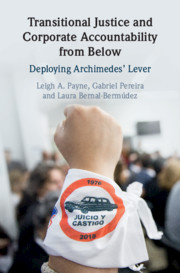Book contents
- Transitional Justice and Corporate Accountability from Below
- Transitional Justice and Corporate Accountability from Below
- Copyright page
- Contents
- Figures
- Tables
- Images
- Acknowledgments
- Introduction Transitional Justice and Corporate Accountability
- 1 Corporate Accountability from Below
- Part I Obstacles to Corporate Accountability
- Part II Accountability from Below
- Conclusion The Impact of Accountability from Below
- Appendices
- Bibliography
- Index
Introduction - Transitional Justice and Corporate Accountability
Published online by Cambridge University Press: 10 April 2020
- Transitional Justice and Corporate Accountability from Below
- Transitional Justice and Corporate Accountability from Below
- Copyright page
- Contents
- Figures
- Tables
- Images
- Acknowledgments
- Introduction Transitional Justice and Corporate Accountability
- 1 Corporate Accountability from Below
- Part I Obstacles to Corporate Accountability
- Part II Accountability from Below
- Conclusion The Impact of Accountability from Below
- Appendices
- Bibliography
- Index
Summary
This chapter provides an overview of the book in terms of concepts and content. It introduces the reader to the questions of what accountability for corporate complicity in human rights violations is, why they take place, and when, where, and how they unfold. It also explores obstacles that have blocked accountability efforts. The chapter sets out the concepts of “corporate,” “complicity,” “accountability,” and “transitional justice.” It examines when and why there is need for accountability for these types of violations.It further considers where corporate accountability could take place, in courts and in truth commissions. The chapter sets out the argument for how accountability processes have occurred, their reliance on civil society demand and institutional innovators to overcome the absence of international pressure and the obstacles posed by a powerful business veto. It uses these factors to present the “justice from below” model used in the book. It suggests that the model functions like Archimedes’ Lever in putting the right tools in weak hands to lift the weight of international human rights accountability. A chapter outline is also provided.
Keywords
- Type
- Chapter
- Information
- Transitional Justice and Corporate Accountability from BelowDeploying Archimedes' Lever, pp. 1 - 20Publisher: Cambridge University PressPrint publication year: 2020



